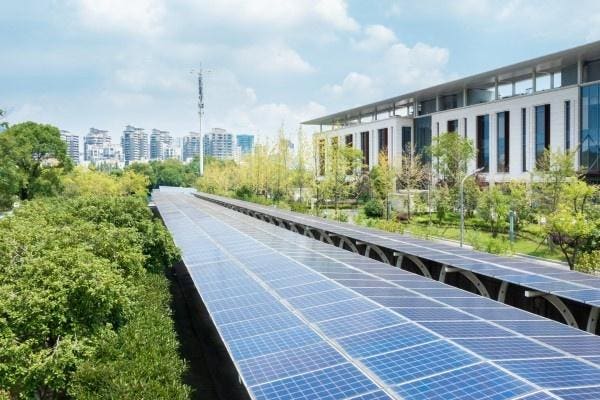The escalating global natural disasters underscore the urgency of addressing climate change if we are to meet the Paris Agreement’s 1.5-degree target. Achieving net-zero emissions by 2050 requires thorough planning, cutting-edge technology, and universal commitment. While there’s a clear push towards replacing fossil fuels with cleaner alternatives, a significant challenge remains.
The “electrification of everything” is vital, but with current complex dependencies, this shift requires our urgent attention. As highlighted in the recent Infrastructure Transition Monitor, only 30% of organizations have made advanced progress in key decarbonization areas, such as the electrification of core operations.
Demand and the electrification tightrope
Current global energy grids, built on a century’s foundation, are struggling to meet the rising energy demands from electrification. While expanding the grid requires significant time and investment, digitalizing existing infrastructure offers a solution for quicker electrification and decentralization.
According to the International Energy Agency (IEA), electricity’s role in global energy consumption will grow. Under existing policies, its share rises from 20% to 28% by 2050. This share will jump to 39% by 2050 if all national commitments are honored. In a net zero emissions scenario aligned with the Paris Agreement, it would reach an impressive 52% by 2050. Encouragingly, renewables, led by PV and wind, account for 75-80% of new installations. Yet, to integrate these sources, modern, flexible, and self-adapting grids are both imperative and achievable through smart grid solutions.
Notably, electrification of transport, industry, and buildings is central to decarbonization efforts. While industry and transport are poised to increase electricity consumption significantly, advancements such as heat pumps and solar make building electrification more efficient. Critical infrastructure’s electrification, including harbors and data centers, relies on on-site renewables and a strong grid. Despite electrification’s strong promise, some sectors with high-intensity heat processes might need alternatives like biomethane and renewable hydrogen.
To achieve net zero decarbonization goals by 2050, significant milestones are required by 2030, such as a 72% share of low-emission power sources and tripling clean technology investments. The IEA emphasizes the importance of a carbon-neutral electricity sector by 2035 in advanced countries. By 2030, renewables are projected to surpass fossil fuels, with solar PV and wind leading global capacity additions up to 2050.
It’s a challenge that requires the involvement of technology. According to the US Department of Energy the growing demand in electricity creates the perfect storm for virtual power plants (VPPs) a portfolio of distributed energy resources leveraging the power of cloud-based software-defined technology. They state that deploying 80-160 GW of VPPs would triple the current scale and by 2030 could support rapid electrification and save the US in order of $10B in annual grid costs.
Tackling the electrification of buildings
Buildings contribute to a staggering 40% of global greenhouse gas emissions annually, with a quarter stemming from construction. Given that by 2040, two-thirds of buildings making up the built environment already exist, their rapid decarbonization is paramount. The future of these buildings hinges on a combination of electrification and digital solutions, incorporating energy-efficient overhauls, the transition to electric HVAC systems, and an emphasis on renewable energy sources. In tandem, building automation solutions can complement these shifts by optimizing resource use.
Electrification of transport, industry, and buildings is central to decarbonization efforts.
The IEA suggests that the building sector could slash its emissions nearly in half by 2030 through electrification and energy efficiency strategies despite the anticipated growth in building sizes and appliance utilization. While European and American legislative efforts have paved the way for energy performance upgrades, there’s a distinct disparity between the outlined vision and real-world action. For a holistic transformation, democratizing access to smart building technologies is vital, ensuring building owners adapt to evolving efficiency standards while balancing occupants’ comfort and safety expectations with operational viability. All data from energy efficiency projects, leveraging digital building platforms, suggest 20-50% savings and often more are achievable depending on the building type and energy tariffs.
Electromobility and transport
Electric vehicles (EVs), owing to their cost-effective, low-emissions advantage, are anticipated to dominate the roads. By 2030, the IEA predicts electric cars could constitute up to 60% of new car sales. This isn’t restricted to personal vehicles; cities like Shenzhen in China showcase the potential with expansive electric bus fleets.
Yet, challenges loom in other mobility sectors. For instance, aviation’s transition to battery power is nascent, making e-fuels an interim solution. Similarly, with its diverse requirements, maritime transport looks to a mix of electrification, green hydrogen, and methanol. Despite the promise of EVs, fossil fuels still dominate, fuelling 90% of transport. With transport demands projected to double by 2050, particularly in burgeoning economies, the emphasis on electrification and the pursuit of net-zero emissions becomes even more pressing, highlighting the need to bolster grid capacity.
Electrification of industry and infrastructure
The path to decarbonizing the industrial sector is complex, requiring an all-encompassing strategy that targets industrial processes, materials, transportation, supply chains, and infrastructure. Central to this transition is electrification, advocating for a shift from natural gas and oil-based systems to electric alternatives throughout the entire value chain. While industrial sites can benefit from on-site photovoltaic (PV) energy generation, it will not suffice, and grid backup remains essential. Tackling high-intensity industries might first involve a coal-to-natural gas transition, but eventually, green alternatives like biomethane and hydrogen will prevail, even if they’re currently more expensive.
Effective carbon taxing can drive the shift towards greener technologies as the demand for carbon-intensive materials like steel and cement surges, especially in rapidly urbanizing regions, thus promoting low-emission alternatives and amplifying recycling becomes crucial. By 2030, with robust policies and mature technologies, the industry could cut its emissions by nearly a quarter from 2021 levels. This is not enough though, since achieving the 1.5-degree target necessitates annual emission reductions of 10%, driven primarily by electrification and supplemented by green fuels and carbon-capture technologies.
Preparing the grid for electrification
Decarbonizing sectors like buildings, transport, and industry will significantly challenge our current grid, which isn’t designed for rapidly increasing capacities and seamless integration of renewables. Countries globally are already grappling with transmission inefficiencies. Modernizing the grid could entail investments up to US$1 trillion and a potential 90% expansion of its capacity by 2050. Building new infrastructure components is resource and time-intensive, emphasizing the need for digital solutions to increase the utilization and push the capacity limits of the energy grid.
According to research, digitalization can save the power industry around USD 80 billion per year, or 5% of total annual power generating costs. And the reason is that the advantages of digitalization are steeped in an increase in the utilization of the networks, a reduction in operating and maintenance expenses, unexpected outages and downtime, improvements in power plant and network efficiency, and the longevity of assets.
With the phasing out of fossil-fueled power plants, the traditional means of stabilizing grid frequency will phase out. Power electronics, particularly decentralized inverters across the network, will be pivotal in ensuring dynamic stability. This necessitates not just grid redesign but also industry-wide collaboration and standardization.
The diminishing role of centralized power plants will push distribution system operators (DSOs) to play a more active role in grid stabilization, a task primarily shouldered by transmission system operators (TSOs) today. Enhanced coordination between TSOs and DSOs can overcome the challenges posed by existing regulations, reducing measures like “redispatches” whereby a throttling of generation capacity is requested by a TSO or proactively planned by power plant operators to avoid grid bottlenecks, which increase consumer costs and hinder decarbonization.
As generation capacity amplifies at the grid’s edge, DSOs often make connectivity decisions without comprehensive data, potentially leading to network disruptions. Incorporating sensors and leveraging AI can optimize this process, but regulatory mindsets must shift to prioritizing such digital advancements over traditional infrastructure upgrades.
According to research, digitalization can save the power industry around USD 80 billion per year, or 5% of total annual power generating costs.
But again, the success of the electrification of everything to a large extent lies in how we use technology, software, sensors, and digital devices. According to research from Brattle, the net cost to a utility of providing resource adequacy from a virtual power plant is roughly 40% to 60% of the cost of the alternative options.
The electrification imperative
The mounting impacts of the climate crisis underscore the dire need for immediate and substantive action. As the Paris Agreement’s 1.5-degree target becomes increasingly elusive, the consequences of our collective apathy threaten to reshape life as we know it. While initiatives like the European Green Deal and the US’s Inflation Reduction Act signify growing momentum, the scale of investment they promise—though substantial—is insufficient to catalyze the comprehensive transition required.
Moreover, the path to decarbonization isn’t solely an ethical mandate; it offers economically viable technological solutions. To maximize the potential of these solutions, we must employ a value tree analysis, guiding investments and technological advancements towards areas that yield the greatest decarbonization dividends. This approach facilitates innovation, minimizes capital expenditure, and optimizes operational costs.
The stakes are unequivocal: Full decarbonization remains an insurmountable goal without robust electrification. We must seize the present moment, leveraging the technologies and digital systems that can lead us towards a fully decarbonized future.
Read the full article here









